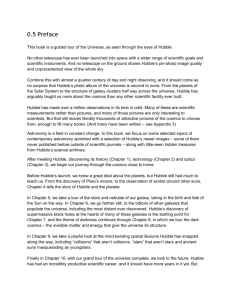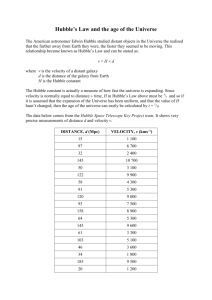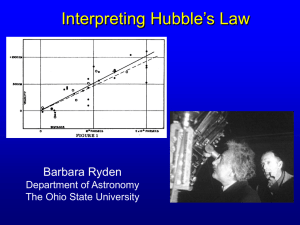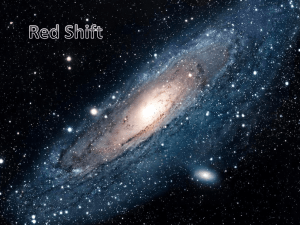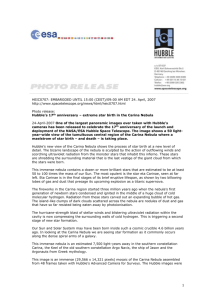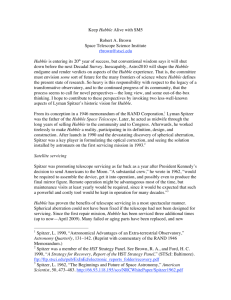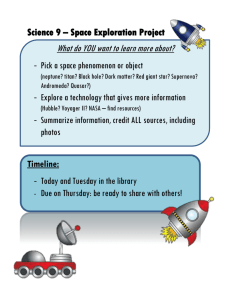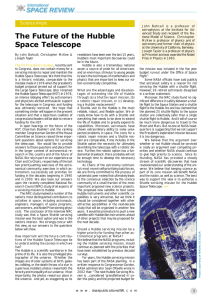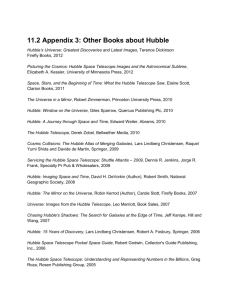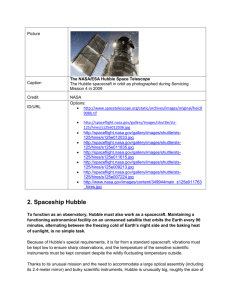11.1appendix1_llc_ar_llc
advertisement
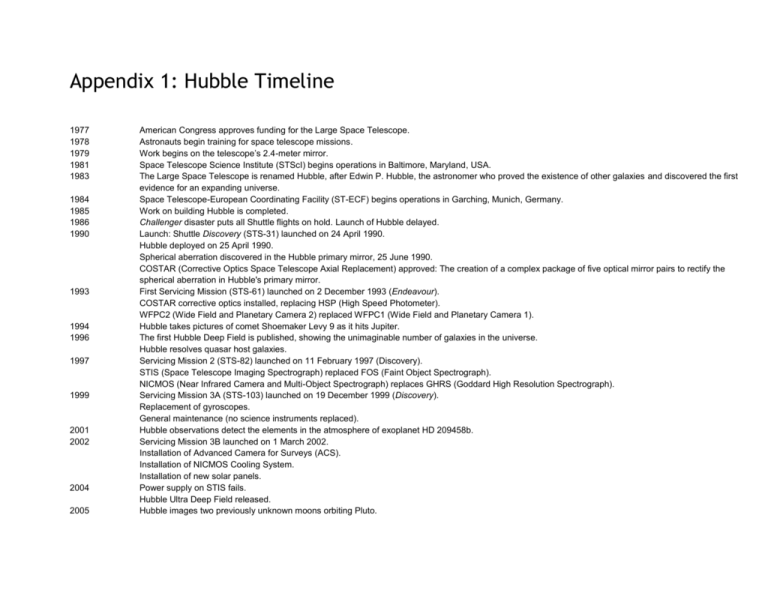
Appendix 1: Hubble Timeline 1977 1978 1979 1981 1983 1984 1985 1986 1990 1993 1994 1996 1997 1999 2001 2002 2004 2005 American Congress approves funding for the Large Space Telescope. Astronauts begin training for space telescope missions. Work begins on the telescope’s 2.4-meter mirror. Space Telescope Science Institute (STScI) begins operations in Baltimore, Maryland, USA. The Large Space Telescope is renamed Hubble, after Edwin P. Hubble, the astronomer who proved the existence of other galaxies and discovered the first evidence for an expanding universe. Space Telescope-European Coordinating Facility (ST-ECF) begins operations in Garching, Munich, Germany. Work on building Hubble is completed. Challenger disaster puts all Shuttle flights on hold. Launch of Hubble delayed. Launch: Shuttle Discovery (STS-31) launched on 24 April 1990. Hubble deployed on 25 April 1990. Spherical aberration discovered in the Hubble primary mirror, 25 June 1990. COSTAR (Corrective Optics Space Telescope Axial Replacement) approved: The creation of a complex package of five optical mirror pairs to rectify the spherical aberration in Hubble's primary mirror. First Servicing Mission (STS-61) launched on 2 December 1993 (Endeavour). COSTAR corrective optics installed, replacing HSP (High Speed Photometer). WFPC2 (Wide Field and Planetary Camera 2) replaced WFPC1 (Wide Field and Planetary Camera 1). Hubble takes pictures of comet Shoemaker Levy 9 as it hits Jupiter. The first Hubble Deep Field is published, showing the unimaginable number of galaxies in the universe. Hubble resolves quasar host galaxies. Servicing Mission 2 (STS-82) launched on 11 February 1997 (Discovery). STIS (Space Telescope Imaging Spectrograph) replaced FOS (Faint Object Spectrograph). NICMOS (Near Infrared Camera and Multi-Object Spectrograph) replaces GHRS (Goddard High Resolution Spectrograph). Servicing Mission 3A (STS-103) launched on 19 December 1999 (Discovery). Replacement of gyroscopes. General maintenance (no science instruments replaced). Hubble observations detect the elements in the atmosphere of exoplanet HD 209458b. Servicing Mission 3B launched on 1 March 2002. Installation of Advanced Camera for Surveys (ACS). Installation of NICMOS Cooling System. Installation of new solar panels. Power supply on STIS fails. Hubble Ultra Deep Field released. Hubble images two previously unknown moons orbiting Pluto. 2006 2007 2008 2009 2010 2011 2012 Hubble observations show that the dwarf planet Eris is bigger than Pluto. The power supply on ACS fails. Hubble images exoplanet Fomalhaut b, one of the first to be confirmed through direct imaging. Hubble completes its 100,000th orbit around the Earth. Servicing Mission 4 (STS-125) launched on 11 May 2009. Installation of WFC3 (Wide Field Camera 3). Installation of COS (Cosmic Origins Spectrograph). STIS and ACS repaired. Gyroscopes and batteries replaced. Soft Capture Mechanism installed. New Outer Blanket Layers installed. Hubble images show distant galaxies with likely redshifts greater than 8, showing the universe as it was when it was less than a tenth of its current age. Hubble makes its millionth observation, a spectroscopic analysis of the exoplanet HAT-P-7b. 10,000th scientific paper using Hubble data is published, identifying the faintest supernova ever to be associated with a long-duration gamma-ray burst. First 3D observations of a filament of the cosmic web in Hubble images of galaxy cluster MACS J0717.


